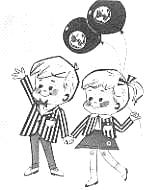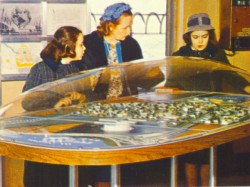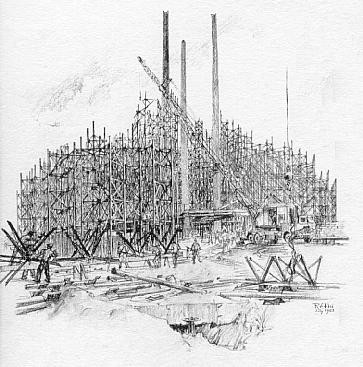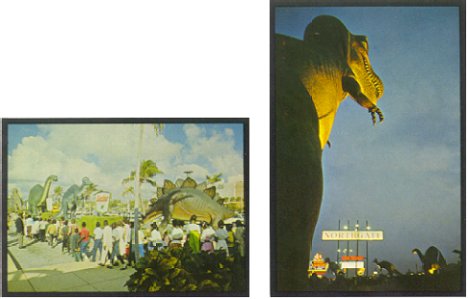|
nywf64.com: What were
some of your responsibilities once you became Director of Public
Relations?
GREG DAWSON: Part of my duties was to be Director of the Press
Building, whatever that meant. And I was also the editor of Fair
News [the monthly Newsletter published by the Fair] and was
responsible for getting out our every-three-month World's Fair
Progress Reports. And here's a little known job I bet you didn't
know existed: I was also the "protector" of the Unisphere.
nywf64.com: You were
the copyright enforcer?
GREG DAWSON: Basically that was one of my jobs although I
eventually hired someone, Henry Lienau, to do most of the work
for me. Since the Fair was licensing a whole group of people
to turn out Fair products, the Fair was obligated to "protect"
the copyright that it had in effect licensed. But at the same
time we certainly wanted people to promote the Fair, in magazines
and newspapers, with displays, promotions in departments stores
and all sorts of other things. For those promotions we needed
to have the logo of the Fair usable. So it was a tricky balancing
act.
The Fair Licensing Department was headed
up by Martin Stone, who later also was in charge of getting industrial
exhibitors into the Fair. Martin had practically invented the
whole field of licensing, starting with Howdy Doody on
television; a property that he owned. All three of the national
networks (NBC, CBS, ABC) licensing departments were created by
Martin Stone, by the way. My department had to be in close contact
with the licensing office. Every request for the use of the Fair
logo which let's face it, is the globe, came to me first
and then I would decide if it was a licensing type of thing or
if we could grant permission for its use as a promotional type
of thing. We handled thousands of requests over the years.
Actual enforcement if someone violated
our rights and used the logo without permission, was handled
by the Legal Department of the Fair and consisted mostly of "cease
and desist" letters. I'm not aware of any specific legal
cases, but there probably were a few. I have no idea if the copyright
has run out or who holds it if it hasn't. I would hazard a guess
that it's in the public domain at this point.
nywf64.com: Were you
responsible for creating and publishing the Graphic Standards Manual that explained
the "correct" use of the Fair's graphics?
GREG DAWSON: I was somewhat involved in it but mainly it was
the job of Dick Gutheridge who did most of the Fair's graphics
jobs such as put together, graphically, Fair News and
the Groundbreaking Brochures and Progress Reports.
Mr. Moses approved the Unisphere logo,
for example, that Dick had designed. The blue and orange colors
were approved by Mr. Moses and Dick found the correct numbers
for the "right" blue and the "right" orange.
Orange and blue are also the official colors of New York City
but they were a different color blue and orange.
nywf64.com: You spoke
of licensing. How did the Fair handle licensing?
GREG DAWSON: Souvenirs were sold all over the world, I believe.
There was no limit on where you could sell your stuff if you
had a license.
Decisions on who got a license were handled
by the Licensing Department and they based their decisions on
the amount people offered to pay the Fair, the quality of their
previous work and how reliable a company they were (did they
pay their bills, for example). Some bums and crooks got through
the net I'm certain but not too many. Martin Stone and his people
were very experienced in this field.
nywf64.com: Did the
Fair Corporation receive a cut of the profits from non-Fair related
souvenirs sold at the various pavilions? How about the sale of
postcards by Dexter Press and the use of the the "World's
Fair Twins" -- were Peter and Wendy a creation of your department?
-
The World's Fair Twins
- a Spertus Publishing creation?
 |
GREG DAWSON: I don't believe the Fair got a piece of [the
proceeds from the] merchandise sold at various pavilions other
than Fair items but I'm not certain. The Fair concession stands
were run by Time-Life, I believe, which also had the rights to
publish the Official World's Fair Guide (which I thought was
pretty bad). I'm aware of Dexter but I'm not aware of the specific
deal they had with the Fair. I believe the "Twins"
was something that was created by Spertus. It wasn't anything
that we created.
nywf64.com: What are
some of the tools you used to sell the Fair?
GREG DAWSON: We had lots of "props." We had posters
-- the blue and red posters, artwork by [artist Bob] Peak, the
green poster which was quite limited in printing and the Whitney
Darrow Jr. Poster of the little boy clinging to his mother's
hand (you see only the mother's hand and leg) and he's holding
a balloon. We had point-of-purchase type displays made by the
Thompson-Leeds company -- small displays that could be set in
windows and on counters.
We had built five rather expensive table
models of the Fair, under a plastic bubble, that we would loan
out to various promotions, primarily department stores when they
planned to build a whole in-store tribute to the Fair, or we
sent them to large event dinners so they could be part of the
cocktail party displays. They were expensive, costing, if I remember
correctly, about $3 thousand each which was a great deal of money
forty years ago. I think, but can't remember exactly, that they
might have been made by the same company that made the models
for our World's Fair model in the Administration Building. But
now that I'm thinking of it, maybe a promotional display company
made them. I'm not certain.
-
Traveling bubble-top
model created to promote the Fair.
 |
The official art, the poster stuff for
example, came from J. Walter Thompson, the Fair's ad agency.
Mr. Moses had absolutely no interest in competitions for any
phase of "official" Fair stuff. At first he said "no
official songs" of the Fair, then turned around and over
lunch one day with his good friend Richard Rodgers said, "Dick,
why don't you write the official song for the Fair?" So
Rodgers did and it was really awful. "Fair is Fair"
is the number and for two years it was broadcast all day long
over the Fair sound system.
The renderings of various pavilions were
done by renderers, those specializing in that type of art. There
were really only a few really good ones that all architects used
so that's why there is a similarity. The Fair didn't pay for
the renderings, the exhibitors did.
nywf64.com: The Fair
publications you were involved in producing are among the best
and most sought-after collectibles of the Fair because they tell
so much about how the Fair came to be. The World's Fair Newsletter,
Fair News, documents this monthly. It's disappointing
that it stopped being published just as the Fair opened. Why
is that?
GREG DAWSON: Because it had done its job. The major purpose
was as a tool to keep interest alive, to let people know what
was happening, to keep the exhibitors together during the three
years that there wasn't really anything other than construction
going on. Once the Fair opened we felt there would be (and there
was) an enormous amount of public attention and anything we could
do in Fair News would be a bit redundant. By the time
the Fair opened, periodicals such as The New York Times
and newspapers around the world would be, in effect, "Fair
News" and frankly they could do a much better job than
we could.
There was talk about putting out something
in the interim [between October 1964 and April 1965], but the
idea was probably dropped because of [lack of] money. By the
time the first year ended the Fair had serious money problems
and the entire Public Relations Department of the Fair was let
go leaving, actually, only one survivor, Bill Berns, and a few
people from the Deegan Company and the Donoghue organization.
But only a few. Tom Deegan and Mr. Moses were hardly speaking.
Deegan who was basically a pretty slimy fellow, was accusing
Mr. Moses of mismanagement, and Moses considered Deegan slightly
lower than a worm at this point.
nywf64.com: The Progress
Reports issued every few months are another valuable collectible
of the Fair. Progress Report Nine, "Builders of the Fair,"
is beautiful with its pencil-art drawings of various pavilions
under construction. How were you able to commission artwork like
that to be done?
GREG DAWSON: Lili Rethi. She was a very nice, very old lady
who came around to see me one day at the Fair and showed me her
work. She was known for her pencil drawings of buildings in construction
and it seemed to me that it might be fun to have her go out on
the site and draw some of the buildings as they went up at the
Fair. Except that the weather was cold. It was winter. But she
didn't mind. She would go out on the site with her drawing pad
and pencils and be there for hours almost turning blue, I'm sure,
but drawing away.
Lili Rethi's pencil drawing of
the Tower of Light
-
SOURCE: NY World's
Fair Corp. Progress Report No. 9
-
September 26,
1963
 |
She did five finished drawings ... Tower
of Light, New York State Pavilion, Kodak and I forget the other
two. You can see all of them in the Progress Report we put them
into. One picture is on the back cover of one Report, I believe.
I don't have mine handy. They are in storage just now. I liked
her. When I left the Fair I took her drawings with me but later,
more or less gave them to Larry Zimm who left them to the Smithsonian
when he died along with other things I once had.
nywf64.com: Your collection
of originals from the Fair are in the Smithsonian now?
GREG DAWSON: Many years [after the Fair] I went to dinner
at a
friend's apartment and there, on his wall, mounted, was one of
the traveling models minus its stand because it was flat on the
wall, like a plaque. The person whose apartment I was at was
a man named Larry Zimm, a designer who specialized in creating
displays for conventions and large sales meetings for major companies.
Larry had a very large, quality, Worlds Fair collection, from
many Fairs, and was interested in both my connection to the '64
Fair and also that I had taken with me when I left the Fair certain
things he wanted to have in his collection.
I had the Worlds Fair poster, done by Whitney
Darrow, Jr., of the little boy being pulled by his mother in
one hand and dragging a Worlds Fair balloon in the other. You
don't see the mother, only her hand. I had the original art work.
Also, I had one of the three posters created by
Bob Peak, the one we called the "red" poster. There
was also a "blue" and a "green" poster. And
I had the originals of the wonderful Lili Rethi drawings, done
in pencil, of Fair buildings in construction. Well, I had all
of these things, and more, and I lent them to Larry to consider
his buying them for his collection and while he was considering
he suddenly died! All of my stuff was over at his place and considered
by his heirs to be part of his estate. I couldn't prove otherwise,
really. So, along with the rest of his collection, my stuff went
off to the Smithsonian, which is just as well. I'm glad it's
safe and being kept for posterity.
I still have some things from the Fair,
including my bound copies of Fair News, the Progress Reports,
the Guide Book, the Fair Souvenir Book and some other things.
And about seven or eight bronze Fair medallions and one in silver.
And a few other mementos including, somewhere in my papers in
storage, some classic memos from Mr. Moses.
nywf64.com: It is
interesting to hear you say "Mr. Moses" when referring
to Robert Moses even to this day. Tell us something about your
former employer.
GREG DAWSON: Most of the people I worked with at the Fair
I liked a great deal. Mr. Moses was an incredible figure, truly
larger than life. Everyone, even his old friends, were in awe
of him. For some reason he had a thing about generals, perhaps
because he was never in the service. But he thought that if you
had been a general, you must be pretty good. So he liked to hire
them. General Myers (a jerk) was head of security. General Potter
was Executive Vice President of the
Fair with the main job of getting the States of the U.S. to participate.
A good man. Later, after the Fair, Joe Potter (actually his name
was William, but everyone called him Joe for some reason) was
hired to be in charge of the building of Disney World in Orlando.
And Col. O'Neal was the chief engineer of the Fair, and afterward
became the chief engineer of the New York City subway system.
I do think that Mr. Moses enjoyed the process
of creating the Fair but once built, that was it -- kind
of like a bridge, of which he built many. I'm not even certain
how many exhibits he actually bothered to go to unless there
was some specific reason like an opening. A great man though
and obviously controversial but larger than life. I have only
met two men that I considered to be larger than life, and that
I have really learned from. One was Moses, and the other was
Tex McCrary.
Mr. Moses was a lightening rod for bad
publicity at that time. He had been a god in New York for such
a long time that his bubble was bound to burst at some point,
like today's stock market. And the difficulties in putting on
a Fair in the United States at that time provided constant grist
for the media's ill mill. He had just come off a scathing fight
which he lost with the young Joe Papp who wanted, and succeeded,
in putting free Shakespeare in Central Park against Moses' wishes.
And he was embroiled in a fight with Governor Nelson Rockefeller
for whom Moses had been a mentor when he was young and growing
up. And also, Moses did indeed have his own agenda, that of finishing
Flushing Meadow Park which he had wanted to do after the '39
Fair but was not able to and improving the highways of Long Island.
Both projects he was able to do because of the '64 Fair, and
frankly, they were the primary reason he took on the job once
Tom Deegan came to him and told him that the Fair could not be
built unless he took over. But the media was gunning for him
from Day One, and they leapt into the fray.
The start of the troubles came when Moses
was unable to persuade the BIE, the Bureau of International Exhibitions,
to "authorize" the Fair as an official World's
Fair. What did that mean? Well, it meant that several major countries
refused to come into the '64 Fair in an official capacity
and Mr. Moses had to get people in various countries to put together
a "national" pavilion of that country. That happened
with many countries. And some countries just never became a part
of the Fair like France and Great Britain. But it was a negative
to the media. And the list of problems, all of which Mr. Moses
miraculously overcame, goes on and on. It truly was an heroic
job for a 70 year old guy.
And, frankly, the media eats up all the
negative crap they can find, don't they? Look at the incredible
concentration of non-news items related to the Chandra Levy mystery.
The other major factor in the perception
of failure of the Fair's first year has to do with the way Fair's
are financed in the US in contrast to other countries where the
countries themselves help or totally finance a World's Fair.
Canada, for example, financed Expo 67 which "lost"
a great deal of money. But because it was government financed
that news was never available to the media. Mr. Moses had to
raise financing by selling bonds in the Fair, to the tune of
some $30 million, a great deal of money then. One of the major
reasons Deegan wanted Moses to take on the Fair job was because
he knew that Moses, and no one else, could get people to buy
Fair bonds. And he did. But Moses backed up his sales pitch by
promising that the Fair would do such great business that they
would get their bonds paid back, 100 cents on the dollar (the
'39 Fair, I believe, repaid only about 30 cents on the dollar).
And so the predictions of Fair attendance were based on figures
that Moses had to have in order to show how the bonds would be
paid back, not based on any kind of scientific formula. I forget
the exact figures, but a prediction of 70 million people was
necessary, I believe, for total attendance for the Fair for the
two years. The fact was, I think, that by the end of the Fair's
two years, 50 million people had come, hardly a failure! But
the press took it on as a "failure" because it didn't
meet the highly publicized predictions ... highly publicized
because Moses needed that publicity to help in the sale of bonds!
I think "hoist on one's own petard"
would apply here.
nywf64.com: Where
did life take you after the Fair?
GREG DAWSON: When I left the Fair I opened my own public relations
company at first called Gregory Dawson Inc., then later it became
Dawson & Royal Inc. because Ted Royal, who had been the account
executive for the Fair at J. Walter Thompson, joined with me.
My staff were all from the Fair since we were all paid a full
year's salary when we left. We could all work, initially for
free, until the little firm got on its feet.
When the Fair ended in 1965, I went to
several exhibitors, Clairol, Sinclair and DuPont specifically,
and talked them into making "road shows" of their exhibits
and taking them to major regional shopping
centers. So for several years we toured, very successfully, the
Sinclair Dinosaurs, all traveling on large flat bed trucks and
kind of in a caravan that created quite a lot of media and public
attention. We staged DuPont fashion shows in centers. And we
created an exhibit out of Clairol's Color Carousel where women
went in and could see, through "magic" mirrors how
they would look with different hair coloring. This exhibit was
carried on two trucks that opened up into a kind of mini version
of the Fair pavilion and stayed in shopping center parking lots.
Sinclair Dinosaur Tour: 1966
-
SOURCE: Gregory
Dawson Inc. Promotional Brochure
|

|
After several years of the PR firm I became
involved in many other activities, including writing an off-Broadway
musical about the Scottish poet Robert Burns called "Great
Scot!" and, in 1973 opened a restaurant and cabaret, first
in the SoHo section of Manhattan, then in 1983 moving to the
Chelsea area, called The Ballroom which became quite successful
and lasted until 1995 -- some kind of record I think. We presented
hundreds of wonderful performers, both new and from the recent
past, including Peggy Lee, Eartha Kitt, Rosemary Clooney, and
many others, and also "discoveries". Throughout all
of this, I also produced many hundreds of other shows in other
places -- too much to go into at this time. For the past ten
years, I have been primarily devoting myself to sculpture and
painting. And that's about it.
nywf64.com: Will there
ever be another Fair like the 1964/1965 New York World's Fair?
GREG DAWSON: After the New York Fair I did consulting work
for HemisFair and for Expo 67, and none of those fairs came even
close to the New York Fair. In truth I don't think you'll ever
see it's likes again because places like Disneyland now fill
that need. And progress, the thing that Fairs traditionally celebrated,
happens just too quickly today. New miracle products appear every
few months, and there's just no need to have a stage to introduce
nylon, or color TV or some of the other things that first came
to public attention via World's Fairs.
|